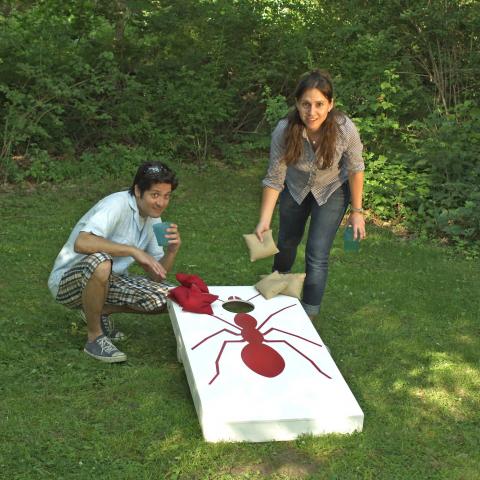A cornhole by any other name....


The game Cornhole is also known by many other names depending on where you live, names such as Tailgate toss, bean bag toss, Sack toss just to name a few.
The earliest known instance of the game is from Heyliger de Windt's 1883 patent for "Parlor Quoits" displays most of the features of the modern game of "cornhole," but with a square hole instead of a round one.
He sold the rights to the game to a Massachusetts toy manufacturer that marketed a version of the game under the name "Faba Baga." Unlike the modern game, which has one hole and one size of bags, a "Faba Baga" board had two different-sized holes, worth different point values, and provided each player with one extra-large bag per round, which scored double points.
In September 1974, Popular Mechanics magazine published an article written by Carolyn Farrell about a similar game called "Bean-bag Bull's-eye." Bean-bag bull's-eye was played on a board the same width of modern cornhole boards (24"), but only 36" long as opposed to the 48" for cornhole. The hole was the same diameter (6") but was centered 8" from the back of the board as opposed to the 9"-center of cornhole boards. Each player threw two bags, weighing 8 ounces each, "in succession." In cornhole, the players alternate throwing 4 bags, each weighing 15.5-16.5 ounces. The boards in bean-bag bull's-eye were placed "about 30 ft. apart for adults, 10 ft. for kids." Scoring was essentially the same as that used in cornhole (3 points for a bag in the hole, 1 point for a bag remaining on the board, and cancellation scoring).
In the Chicago area, cornhole is often referred to as "bags." The game spread in Chicago, Illinois, and the Northwest region of Indiana in the late 1970s and early 1980s, perhaps due to the Popular Mechanics article mentioned above. The game's popularity on Cincinnati's west side in the 1980s spread to surrounding areas in Kentucky and Southeast Indiana.
The American Cornhole League ("ACL") was founded in 2015 by Stacey Moore. According to ACL's website, it promotes and develops cornhole as a sport on every level
In order to score, the bags must either be tossed into the hole or land on the board. A bag that falls through the hole is worth three points. The bag can be tossed directly into the hole, slide into the hole, or be knocked into the hole by another bag. A bag that lands on the board and is still on the board at the end of the inning is worth one point. If a bag touches the ground and comes to rest on the board, it is removed from the board prior to continuation of play and not worth any points (commonly referred to as a "dirt bag"). Scoring is done by cancellation (e.g., if Team A scores 12 points in the frame and Team B scores 10 points in the frame, Team A is awarded 2 points). Play continues until a player or team reaches or exceeds 21 points.
In the common version of cancellation scoring, the total score for each team for the inning is totaled each round, and then the difference of the two scores is awarded to the team with the higher score. It is thus only possible for one team to score points each inning. For example, if one team lands two bags in the hole and one on the board for 7 points, and the other team lands one bag in the hole and two on the board for 5 points, 5 points from the round would cancel out, and the first team would thus score 2 points. Because only one team can score points in each frame, it is impossible for both teams to reach or exceed 21 points in the same inning, and therefore ties are impossible.
A cornhole match is played until the first player or team reaches 21 points at the completion of an inning. The winning team does not need to win by two or more points.
Gameplay strategy varies by player and skill level. At the professional level, players can easily slide all 4 bags into the hole if no bag blocks the path. Defensive strategies are often employed to slow down game play or force opponents to make difficult decisions, such as throwing a blocker bag that rests in front of the hole. This forces an opponent to either slide through the blocker bag to reach the hole, throw another blocker behind the bag, or attempt a riskier airmail shot over the bag (throwing directly into the hole without touching the board).
The American Cornhole League ("ACL") was founded in 2015 by Stacey Moore. According to ACL's website, it promotes and develops cornhole as a sport on every level, and created software and apps to manage cornhole leagues, tournaments, special events, and player development.
Let us know how your best cornhole game went, by posting on our Facebook page at https://www.facebook.com/CustomCornholeBoardsIncorporated